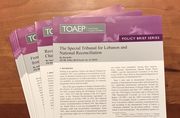Table of contents:
7. The destruction or seizure was not required by military necessity.
7.1. The destruction was not required by military necessity.
7.1.1. Evidence that military operations did not make the destruction absolutely necessary.
7.1.2. Evidence that property belonging to civilians was deliberately targeted and destroyed.
Element:
7. The destruction or seizure was not required by military necessity.
7.1. The destruction was not required by military necessity.
In the Katanga Trial Judgement, the Trial Chamber held that:
"To fall within the ambit of article 8(2)(e)(xii) of the Statute, partially or totally destroyed property must be protected by the international law of armed conflict, that is, it must not constitute "military objectives". Military objectives are those "objects which by their nature, location, purpose or use make an effective contribution to military action and whose total or partial destruction, capture or neutralization, in the circumstances ruling at the time, offers a definite military advantage."It is therefore important to assess the "military advantage" from the attackers perspective for each targeted object, and such an advantage must be definite and cannot in any way be indeterminate or potential. The Chamber recalls in this regard that it is for the Prosecution to establish that the destruction is not justified by military necessity. In such a case, civilian objects lose their protection only for such time as they are military objectives.
The destruction of property therefore does not constitute a crime under article 8(2)(e)(xii) of the Statute where such destruction is justified by military necessity. As did the Appeals Chamber of the ICTY in Kordić and Čerkez, the Chamber will adopt the definition of "military necessity" in article 14 of the Lieber Code of 24 April 1863, which lays down: "Military necessity [...] consists in the necessity of those measures which are indispensable for securing the ends of the war, and which are lawful according to the modern law and usages of war". With respect to this exception, article 8(2)(e)(xii) refers explicitly to cases where the destruction " [is] imperatively demanded by the necessities of the conflict". The Chamber observes that only "imperative" reasons of military necessity, where the perpetrator has no other option in this regard, could justify acts of destruction which would otherwise be proscribed by this provision. To determine whether the destruction of property fell within military necessity, the Chamber will conduct a case-by-case assessment by considering, for example, whether the destroyed property was defended or whether specific property was destroyed." [15]
In Blaškić, the Trial Chamber held that:
"Similar to the grave breach constituting part of Article 2(d) of the Statute, the devastation of property is prohibited except where it may be justified by military necessity."[1]
The Đorđ;ević Trial Chamber stated that:
"The property destroyed must not have been used for military purposes at the time when the acts of hostility directed against this property took place. This is equally applicable in the case of the destruction of religious sites. The "military purpose" exception to the protection of institutions dedicated to religion has been confirmed consistently by this Tribunal. It is for the Prosecution to establish that the destruction or damage was not justified by military necessity."[2]
The Trial Chamber in Stanisic and Zupljanin held that:
"[...] the property in question must not have been used for a military purpose at the time when the acts of hostility directed against it took place. According to the Appeals Chamber in the Brđ;anin case, the burden is on the Prosecution to establish that the destruction or damage in question was not justified by military necessity. The Appeals Chamber also held that determining whether the destruction or damage occurred due to military necessity involves determination of what constitutes a military objective, referring to Article 52 of Additional Protocol I as containing the widely acknowledged definition of military objectives. The fact that the building in question was located in the immediate vicinity of the military objectives does not justify its destruction because it is its use, and not its location, that determines the loss of protection."[3]
7.1.1. Evidence that military operations did not make the destruction absolutely necessary.
In the Katanga Trial Judgement, the Trial Chamber held that:
"Additionally, under customary law, attacks directed at military objectives may cause "collateral civilian damage" which is not unlawful per se, provided that the rules of custom prescribing proportionality in the conduct of hostilities were respected. The principle of proportionality defined in article 51(5)(b) of Additional Protocol I proscribes "an attack which may be expected to cause incidental loss of civilian life, injury to civilians, damage to civilian objects, or a combination thereof, which would be excessive in relation to the concrete and direct military advantage anticipated." [16]
7.1.2. Evidence that property belonging to civilians was deliberately targeted and destroyed.
7.2. The seizing was not justified by military necessity.
The Trial Chamber in Gotovina et al. states that:
"[...] the appropriation must have been unlawful. In certain circumstances appropriation of property may not be regarded as unlawful where it can be justified under international humanitarian law. Under international humanitarian law there is a general exception to the prohibition of appropriation of property when the appropriation is justified by military necessity. In the context of an international armed conflict, treaty law and international customary law justify battlefield seizures of military equipment of the adverse party as war booty."[4]
"With regard to all incidents of appropriation for which the property was specified, the Trial Chamber found that it consisted of personal, domestic, or agricultural items or vehicles, or animals. Considering this, as well as the circumstances under which the appropriation took place, the Trial Chamber finds that the acts of appropriation with regard to those incidents were not justified by military necessity, and they were unlawful."[5]
Footnotes:
[1] ICTY, Blaškić Trial Chamber Judgement 3 March 2000, para. 183.
[2] ICTY, Đorđević Trial Chamber Judgment 23 February 2001, para. 1772.
[3] ICTY, Prosecutor v. Stanisić and Župljanin, "Judgment", IT-08-91-T, 27 March 2013, para. 90.
[4] ICTY, Gotovina et al. Trial Chamber Judgment 15 April 2011, para. 1779.
[5] ICTY, Gotovina et al. Trial Chamber Judgment 15 April 2011, para. 1783.







